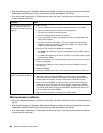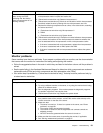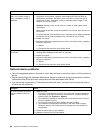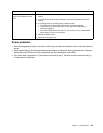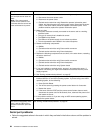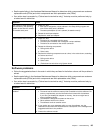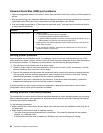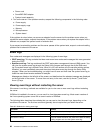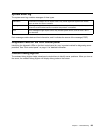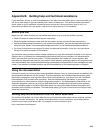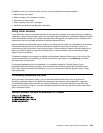
• Power cord
• ServeRAID SAS adapter
• System board assembly
4. Turn on the server. If the problem remains, suspect the following components in the following order:
a. Power supply
b. Power-supply cage
c. Memory
d. Microprocessor
e. System board
If the problem is solved when you remove an adapter from the server but the problem recurs when you
reinstall the same adapter, suspect the adapter; if the problem recurs when you replace the adapter with a
different one, suspect the system board or extender card.
If you suspect a networking problem and the server passes all the system tests, suspect a network cabling
problem that is external to the server.
Event logs
Error codes and messages are displayed in the following types of event logs:
• POST event log: This log contains the three most recent error codes and messages that were generated
during the POST.
• System-event log: This log contains all the POST and system management interrupt (SMI) events. You
can view the system-event log through the Setup Utility program and through the as the IPMI event
log.
The system-event log is limited in size. When it is full, new entries will not overwrite existing entries;
therefore, you must periodically save and then clear the system-event log through the Setup Utility
program. When you are troubleshooting, you might have to save and then clear the system-event log to
make the most recent events available for analysis.
Messages are listed on the left side of the screen, and details about the selected message are displayed
on the right side of the screen. To move from one entry to the next, use the Up Arrow (-) and Down
Arrow (¯) keys.
Viewing event logs without restarting the server
If the server is not hung, methods are available for you to view one or more event logs without restarting
the server.
If IPMItool is installed in the server, you can use it to view the system-event log. Most recent versions of
the Linux operating system come with a current version of IPMItool.
The following table describes the methods that you can use to view the event logs, depending on the
condition of the server. The rst two conditions generally do not require that you restart the server.
Table 30. Methods for viewing event logs
Condition Action
The server is not hung and is connected to a network. Use IPMItool to view the system-event log.
The server is not hung and is not connected to a network. Use IPMItool locally to view the system-event log.
The server is hung.
You can restart the server and press Del to start the Setup
Utility program and view the system-event log.
98 ThinkServer Installation and User Guide



